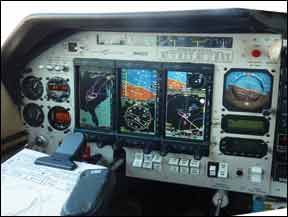If youre committed to the account-draining task of a major avionics upgrade, your sights are likely set on either of the two most sought-after systems for the aftermarket: Garmins G500 and the Aspen EFD1000-series. We think buyers go into the decision-making process smitten by the G500s bigger size, and for bigger, more valuable airplanes, its easy to label the G500 a logical fit. But our experience is that Aspen wins the install bid more often than Garmin. Why? Its the install complexity that ultimately rules the decision even when a buyers heart is set on the G500 from the get-go. That said, keep in mind that to compare apples to apples, you need two Aspens to equal a single G500.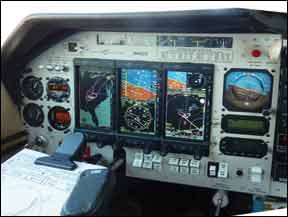
Aircraft in the 6000- to 12,500-pound category have only one choice: Garmins $30-grand G600 system. The G600s software is certified for this class and the system is sold soup-to-nuts with little in the way of add-on options. Aspens EFD1000C3 flavor is aimed at Class III applications. The a-la-cart G500 is aimed at the lighter stuff and owners can add charting, SVT synthetic vision and other options as needed to keep the total cost a bit more in check.
The G500 stands out in the marketing propaganda because it looks bigger-and it is. The Garmin has dual screens (PFD and MFD) housed in a single bezel. Each color LCD screen measures 6.5-inch diagonal with 640×480 VGA resolutions, displaying 65,536 colors. Some owners react that the machine looks smaller in the panel than they envisioned after eyeing the brochures. This could be an illusion for large panels. But, on a small panel like in a Mooney or Skylane, the G500 is dominant.
Aspens PFD is a single 760×400 32,768-color LCD screen design that measures six inches. The bezel width is such that it fits dead center in the middle of the six-pack, sliding through the existing three-inch instrument cutouts and secures to a rectangular, surface-mounted bracket. There’s a flush-mount option, but it requires chopping of metal-just like the G500. An optional second or third screen, the 1000- and 500-series MFD, can occupy the space to the left or right. A dual screen setup is called the Evolution 2000.
The Aspen display has data bars that split it into a top and bottom half. Measure the total viewable area above that data bar (which contains horizon and airspeed and altimeter tapes) and you get an area thats roughly 2.50 inches high and 2.75 inches wide. The G500 is clearly wider at four inches. Thanks to that extra screen space, the G500 on-screen nomenclature is stamped in a larger font that buyers are, not-surprisingly, drawn to. The size also makes the G500 PFD screen look less busy than the Aspen.
Aspens latest software (2.3.3) increases font size for airspeed, altitude bug, tape and drum values, baro setting, selected heading and course while also increasing the size of the values in the data bar. This is a big improvement, even for our 40-something-year-old eyes. On the topic of software, both systems have software platforms that are easily upgradeable in the field, in most cases.
Installation RealityMany of the systems flight-critical electronics live inside the EFD1000 display, which saves critical space and installation effort. It includes the AHRS and a digital air data computer that has pitot and static fittings on the back of the display chassis, an input-output processor (IOP) and of course a main system processor. A configuration module stores installation, aircraft-specific calibration, and user data settings so swapping out a display requires no reconfiguration. Housed in the rear of the display is a cooling fan and backup battery that has enough juice for 30 minutes of display life. A remote sensor module (RSM) containing a magnetometer, OAT sensor and GPS receiver is mounted on the airframe.
A complete G500 is composed of the GDU620 display and remote units: a GRS77 AHRS, GDC74A air data computer, a temperature probe and GMU44 magnetometer. There’s no backup battery.
The single-screen Aspen weighs roughly three pounds, while the G500 is closer to
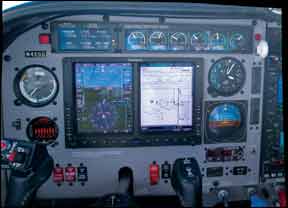
15 pounds, including the huge wiring bundles (some of which is Ethernet) routed between all of those remote boxes.
Aspen understood early on that radio stacks have a smorgasbord of equipment and designed to play with the crowd. The mysterious remote analog converter unit (ACU) converts analog signals to digital format, allowing vintage nav radios to play on the Aspen electronic HSI.
G500 is snobbish in comparison, accepting input from the world-conquering GNS-series (and now GTN700 and 600 systems) and the Garmin-AT SL30 Nav. Have a KX155 you want to feed the G500? It wont work, so you’ll need to retain it stand-alone or buy a 430. For some buyers this is a deal-breaker.
On autopilot interconnects, both systems are liberal. Garmin was the first to offer a digital autopilot emulator with the GAD43 that can replace Bendix/King and some Collins autopilot gyros. Aspen joined the party with the EA100 emulator, which at this time only has Bendix/King emulation. Aspen said its working on a Century and ARC interface. S-TEC interfacing would require turn-coordinator emulation and isn’t in the plans for either system. The G500 can command the S-Tec the remote altitude preselector with a $2995 enablement card. The Aspen cannot. In our trials, both the EA100 and GAD43 work flawlessly and jump-start older analog autopilots while increasing reliability.
Both systems include integrated GPS roll steering (GPSS), which is a dollar saver since you wont need to buy the $3000+ GPSS upgrade for your existing autopilot. Aspen makes GPSS more seamless, however, with on-screen control. The G500 requires an external switch, increasing the install effort and operational complexity.
On the topic of GPSS, one function we like in the Aspen GPSS is the wings-level mode. If the GPSS is active and the GPS source is lost (not unheard of and often unrecognized by the pilot) the GPSS mode automatically switches to wings level and alerts the pilot to select another means of tracking.
The G500 accepts oodles of re-mote inputs including the GDL69 XM receiver, a wide variety of traffic systems and the L-3 WX500 sferics. Garmin says it might work with Avidynes TWX-series sferics. Aspen plays XM with the EWR50 Evolution Weather Receiver or Heads Up XMD76. Garmins GDL69 wont work.
Truly La Carte
A huge selling point for Aspen is the incremental upgrade potential. Simply add a second or third screen as budget allows. Like the right half of a G5000, the second screen is for playing weather, terrain and georeferenced NACO charts but the wider
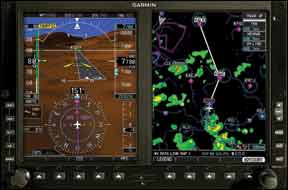
screen area on the Garmin makes for a nicer chart presentation, in our view. There’s also traffic overlay that can play on a single EFD (as can XM weather) with appropriate software. It takes two Aspens to challenge a G500.
But pairing Aspen displays also provides redundant backup and flight data integrity cross-checking with dual-AHRS. There’s also split-screen data capability. The reward for this extra cost and install effort is a regulatory green-light for removing all of the backup flight instruments except the attitude gyro. Note that you’ll need the 1000MFD and remote battery for this. The lower-end 500-series MFD wont allow reversion to function as a backup PFD.
A single G500 offers little in the way of single-point display failure redundancy. If the screen fails, youre now on the steam gauge backup instruments.
But thats not the whole story. The Evolution systems Achilles heel is pitot-static blockage. Loss of either pitot or static data will not only remove the airspeed and altitude, it will remove heading and attitude on all Evolution displays because its reliability may be in question. It will also take down the autopilot if youre using the EA100 to drive it. Good thing you still have that retained attitude gyro.
Aspen told us certification without traditional horizon gyro is on the doorstep, and the new software wont remove the attitude data. It may still be unreliable, however. The G500 will still provide attitude data without airspeed input.
While were talking about dependent systems, flying IFR with an Evolution requires an IFR GPS is installed and working.
We think the G500 MFD capability exceeds the Aspen, if simply because it is that much bigger. It can also overlay ship radar. The G500 has FliteCharts (NACO approach charts) and SafeTaxi standard. The pricey Jeppesen ChartView is optional. Aspen offers NACO charts only, but they are georeferenced (your position is shown on the chart) where FliteCharts are not. An annual Flite-Chart subscription for the Garmin is $395. For the Aspen, its $299, and is supplied by Seattle Avionics.
Aspen should soon offer synthetic vision for $2995. For multi-screen setups, the syn vision cross-feeds among displays. Garmins SVT is wonderful on the G500 and worth the $4995 option. we’ll have to fly it on the Aspen to see if the extra visual information overloads the already-busy display.
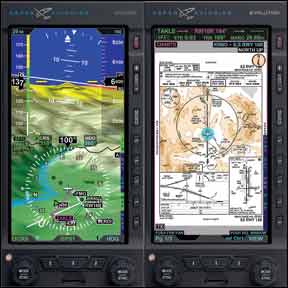
We don’t care much for the Aspens rate of turn indicator, a curved white line on either side of the heading, with tick marks for full and half-standard rate turns. Were not fans of the Aspens small and non-linear vertical speed indications that disappear in calm air. Because of this, some owners insist on retaining the round-gauge VSI in the panel.
Lacking in the Aspen is audio output. The G500 altitude bug provides aural (and visual) alerts within 200 feet of, or when deviating 200 feet beyond, a bugged altitude.
Decision Time
A basic G500 without SVT or GAD43 emulator retails for $15,995. The best equivalent Aspen system would be the Evolution 1500 package (no backup attitude option) for $14,990. Invest in the worthwhile SVT and GAD43 emulator for your autopilot and you get a G500 at $23,985. The better Aspen would be an Evolution 2000 (backup attitude capable), EA100 for the autopilot, remote battery and the planned synthetic vision ($2995) for $22,780. Average install labor favors the Aspen, widening the takeaway price gap.
For lean budgets, a single-screen Aspen offers decent amounts of utility if you can accept that its a major step down from a G500 and offers little MFD function. On the other hand, its liberal when playing with radios old and new and requires little if any instrument panel modification. With an out-the-door installed price that could fall we’ll south of $15,000, we think its a solid value with room to grow if you find a pot of gold a year later.
No solution is for all cockpits, and the G500 has the advantage in feature set and screen size. We also like its audio outputs, and autopilot vertical speed and altitude selector. Its the only choice if you want to wrap in on-board radar.
Heres a final thought for you: Expect a sizable learning curve with either system. A seasoned ATP told us it took him a solid 10 hours of VFR flying before he became comfortable going it IMC behind the Aspen in his single turboprop. This was after misprogramming the GPSS botched a departure procedure and turned him the wrong way after launching into the clouds. The last piece of equipment that must be upgraded with any of these installs is the one between the yoke and the seatback.

